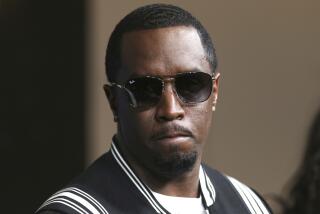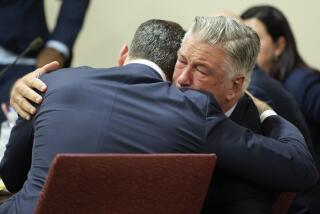Simpson Attorneys Draft Motions to Challenge Case
- Share via
Attorneys for O.J. Simpson already have begun preparing a battery of motions in an attempt to undermine the prosecution case against the superstar and to bolster his contention of innocence, Simpson’s lead lawyer said in an interview Tuesday.
“We are only going to file motions that are legally supportable and that support O.J.’s innocence,” said Robert L. Shapiro, the Los Angeles lawyer who heads Simpson’s high-profile legal team. “We are not going to file anything frivolous.”
Among the motions being drafted, Shapiro said, is one to dismiss the case based on a lack of prosecution evidence presented during the preliminary hearing directly linking Simpson to the murders of his ex-wife, Nicole Brown Simpson, and her friend, Ronald Lyle Goldman.
At the same time, Shapiro said, defense attorneys will introduce a motion contesting evidence obtained during a warrantless search of Simpson’s home and another to challenge evidence seized under a subsequent search warrant. In addition, a number of so-called in limine motions seeking to limit evidence or testimony in the case probably will be offered, he said.
Those are only a few of the challenges being mounted to the prosecution case, Shapiro said, adding that he and other Simpson attorneys spent most of Monday and Tuesday drafting motions and sharing them with their client during the limited visitation hours at the Men’s Central Jail. Despite the extensive motions envisioned, Shapiro is pressing for an early trial--perhaps as soon as late September.
As Simpson’s lawyers launch the next phase of their assault on the prosecution case, investigators continue to sift through evidence and chase down leads.
On Tuesday, detectives presented to the district attorney’s office the results of the Police Department’s investigation of Al Cowlings, who came to his former teammate’s aid on the day Simpson failed to surrender to police as promised. The police file details evidence so that prosecutors can decide whether criminal charges are warranted, officials said.
*
Meanwhile, detectives and prosecutors continued to pursue their principal target. Detective Tom Lange, one of two lead investigators in the Simpson case, traveled to the Men’s Central Jail on Tuesday to collect a hair sample from the athlete-turned-actor. Simpson’s hairs will be compared to strands recovered from a blue knit cap found at the Brentwood murder scene.
In addition, law enforcement sources said Tuesday that prosecutors have met for the first time with a witness who said she saw a car resembling Simpson’s near the scene of the crime on the night the murders took place.
That witness, a young woman who was jogging in the neighborhood shortly before the killings, met with homicide detectives last month. In an interview with The Times the same day, she said she could not see anyone inside the car but that the vehicle looked like Simpson’s white Ford Bronco. She said the car arrived between 9:45 p.m. and 10:10 p.m. and parked near Nicole Simpson’s home.
The jogger, who said she stopped circling the block about 10:10 p.m., did not witness the killings. One prosecution witness at the preliminary hearing told of hearing a dog bark about 10:15 p.m. to 10:20 p.m., while another said he found Nicole Simpson’s dog, its paws bloody, wandering nearby shortly after 10:30 p.m.
Nevertheless, the jogger’s description of the car near the murder scene could bolster the prosecution’s attempts to undermine Simpson’s alibi and show that he was in the vicinity when the crimes were committed. Simpson’s lawyers have said he was at home waiting for a limousine to take him to the airport when Goldman and Nicole Simpson were killed, but the limousine driver testified during the preliminary hearing that Simpson did not answer his door until just after 11 p.m.
When Simpson did answer the door, he apologized for having overslept, the driver said.
Although authorities continue to interview witnesses and await test results to determine the source of blood samples found at the scene of the crime and at Simpson’s Brentwood estate, the next public announcement is likely to be the decision on whether to prosecute Cowlings, who was booked last month on suspicion of aiding a fugitive.
If convicted of harboring or concealing a person wanted for committing a felony, Cowlings could face a year in prison and a fine of $5,000. His lawyer, Donald Re, has said Cowlings was not attempting to help Simpson flee, but rather was trying to keep him from committing suicide.
Police sources said Tuesday that they doubted whether a case would be filed, in part because of Cowlings’ public role in bringing Simpson home, where both men were arrested after a breathtaking standoff in the driveway as helicopters hovered overhead and a crowd gathered outside the gates.
*
Officers at the scene of Simpson’s surrender said Cowlings interfered with their efforts to negotiate with the ex-athlete, and Cowlings was arrested along with Simpson. But those same officers also credited Cowlings with coming to their aid when Simpson’s cellular telephone battery died and they needed to deliver a new phone to him.
At their request, Cowlings delivered the new phone. That saved officers from having to expose themselves to Simpson, who had a loaded pistol.
Given those and other circumstances, legal experts generally agreed that a case against Cowlings would be problematic.
“The question for prosecutors is: ‘Could you ever convince a jury beyond a reasonable doubt that he was helping Simpson flee?’ ” said Myrna Raeder, a law professor at Southwestern University School of Law. “It would be a difficult case for the prosecution.”
What’s more, experts said, prosecuting Cowlings could complicate the case against Simpson. A spokeswoman for the district attorney’s office said Simpson prosecutors Marcia Clark and William Hodgman were being consulted for their opinions about whether to proceed against Cowlings.
“They shouldn’t prosecute Cowlings,” Danny Davis, a leading defense attorney in Los Angeles, said of prosecutors. “It’s a briar trap that Brer Rabbit has laid for the district attorney.”
For one thing, experienced lawyers said, Cowlings could try to call Simpson to testify on his behalf, a move that might offer Simpson a platform to tell his story of failing to surrender to police without facing questions about his alleged role in the murders of Nicole Simpson and Goldman.
If called to testify, Simpson could choose to take the stand, or, far more likely, would invoke his right against self-incrimination.
“There are too many land mines for (Simpson) to step on,” defense attorney Michael Yamaki said of the possibility of Simpson testifying in Cowlings’ case. “Even the most innocent statement can be misinterpreted.”
Even without Simpson taking the stand, however, the Cowlings case would almost certainly feature testimony--either from him or from other occupants of the house in the hours before Cowlings and Simpson disappeared--about Simpson’s state of mind.
Assuming that Cowlings or other witnesses in his case testified that Simpson was distraught or bereft over the death of his ex-wife, that testimony could help Simpson at his own trial, particularly if those witnesses indicated that Simpson was not attempting to flee when he left the house that day.
There is yet another consideration in prosecuting Cowlings, legal experts said. If prosecutors bring a case against Cowlings and lose--a possibility made more real by the fact that Cowlings’ attorney, Re, is among Los Angeles’ most admired defense lawyers--it could create a public perception of weakness in the Simpson case.
“Cowlings is a shoe-in for a sympathetic acquittal,” Davis said. “And that could become a harbinger of defeat for the district attorney’s case against O.J. Simpson.”
Cowlings is scheduled to appear in court Friday. A decision on whether the district attorney’s office will prosecute him could be announced before then.
More to Read
Sign up for Essential California
The most important California stories and recommendations in your inbox every morning.
You may occasionally receive promotional content from the Los Angeles Times.











